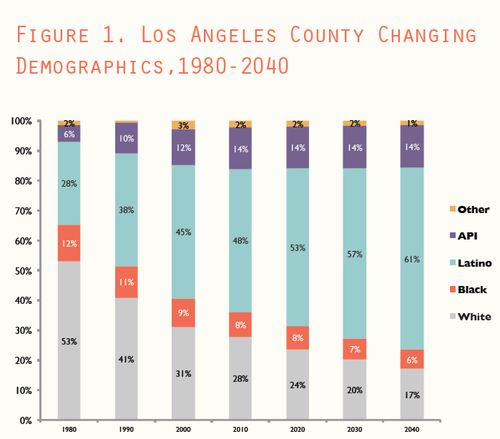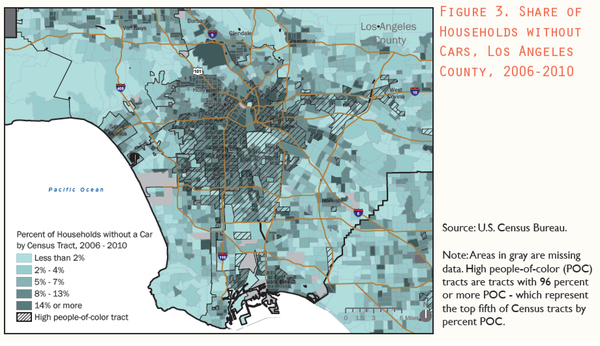A Vision for the Next Los Angeles: Transportation Equity and Just Growth


L.A. in Motion, a series exploring transportation equity in Los Angeles, is produced in partnership with the California Endowment.
KCET Departures is partnering with the Program for Environmental and Regional Equity (PERE) at the University of Southern California on a series of articles -- which we call L.A. in Motion -- exploring what transportation equity means for Los Angeles and its residents.
If you ask people -- including Angelenos -- about Los Angeles, a range of images immediately come to mind: our car culture, our suburban sprawl, and our stark divisions by race and income -- that are now characterizing the rest of America.
But is that old version of Los Angeles really who we are now?
The fact is that the next Los Angeles is being remade before our eyes -- and while there is much to be done, there is a lot that is going right. We are in the midst of a reinvention of sorts: from sprawl to community development, from car dependence to transit orientation, from rising inequality to a growing commitment to equity and inclusion.
Indeed, Los Angeles has been a place for innovation around matters of equity for some time, particularly in the field of transportation. We successfully insisted on better bus service, pioneered clean trucking and shipping at our ports, and have even taxed ourselves to expand our transit network.
Seeing the New in Los Angeles
Consider our massive investments in rail and bus, and the fact that young people are increasingly embracing mass transit (Sivak and Schottle 2012). Consider the shift of development activity from the ex-urbs to neighborhoods bordering our central city (such as Echo Park and Koreatown), as well as the boom of residential living in downtown L.A.
Consider the way in which community-based groups have risen to articulate their concerns, positioning L.A. as a national leader in social-movement organizing. Think about the way in which immigrant integration has been mainstreamed and school discipline policies have been challenged (i.e. curbing truancy tickets).
And reflect on the multicultural mix that is now producing new art and music (rather than riots and rebellions), as well as the multifaceted efforts to ameliorate income disparities through community benefits agreements, living wages, and so much more.
In short, L.A.'s organizers, advocates, government agencies, funders, and civic leaders are starting to transform our region into a model of a more equitable and sustainable world. Shedding the weight of old misconceptions about Los Angeles means creating a new vision for ourselves -- an aspirational, inspirational, and achievable one -- toward a more inclusive, more socially connected, more economically vibrant region.
A Vision for Equity in Transportation
To do this, "The Next Los Angeles," as coined by Robert Gottlieb and colleagues in the book, will need to celebrate the rich cultural and racial diversity that has made L.A. a world-class city for innovation and economic vitality, while also recognizing that the majority of residents who make this possible come from low and moderate-income households.
Transportation is a key part of this new vision. All Angelenos -- including those without access to cars -- deserve more affordable, responsive, and safer transportation choices -- be it through walking, biking, or transit. And transit can be key for what we call "just growth" -- blending growth and equity concerns in ways that maximize environmental sustainability, job creation, and community development.
According to the Southern California Association of Governments, our region is expected to grow by 4 million people by 2035, leading to more demands for housing, jobs, education, and adequate transportation options. This, and the state-mandated Sustainable Communities Strategy, makes it imperative for us to find a common language and understanding of why equity in transportation matters to the future growth and sustainability of our region.
We at the Program for Environmental and Regional Equity (PERE) at USC are committed to sparking new conversations that bring together the usual and not-so-usual suspects. And we think that one way to do this is to focus on what we call "Just Growth."
What's Just Growth?
What does "Just Growth" mean? To some extent, it's a play on the idea that some folks think that growth alone -- just growth -- will solve our economic problems. What we have found -- and it's echoed in studies by the Cleveland Federal Reserve -- is that sustainable growth requires attention to fairness.
In fact, the new research suggests that places with less inequality have more resilient and robust economies. Regions that work toward equity have stronger and more resilient economic growth -- for everyone. Social inclusion is the key to prosperity, and should not just be an afterthought.
In our recent report, "An Agenda for Equity: A Framework for Building a Just Transportation System in Los Angeles County," we apply this "Just Growth" framework to transportation. We suggest that transportation equity means putting people first, and transportation equity is one of the best examples of "Just Growth."
Indeed, transportation is a sort of "just growth sweet spot" -- it connects people to jobs, generates transit-oriented housing development, affects our overall health and environments, among other things. This is especially true as massive investments to the tune of $40 billion dollars in transportation build-out are planned for the next 30 years ahead.
Where Are We Now? Transit and Demography in L.A.
Other findings from our research at USC PERE show that immigrants and low-income communities of color disproportionately miss out on the benefits of regional transportation investments. At the same time, they disproportionately suffer from the burdens of transportation infrastructure, like pollution from cars on highways. The images below illustrate the demographic data underscoring the factors at play in our region.

Our regional population growth will be coming from the Latino population (Figure 1). Figure 2 shows that while ridership declines as income rises, even at the highest income bands Blacks and Latino immigrants have some of the highest rates of transit use. Certain segments of the growing Asian population are also transit dependent, particularly lower-income Filipino immigrants and the Chinese and Vietnamese populations near downtown L.A.

As the era of mass immigration ends (the share of the foreign-born has been on the decline in Los Angeles for the past several years), the fact that U.S.-born Latinos in higher income bands have very low rates of ridership is concerning for those worried about pollution associated with driving. It is also startling that the use of public transit by non-Hispanic whites remains so low at every point on the income spectrum. The upshot is that we should work to serve the willing: We should build a transit system that emphasizes keeping these riders riding even as we continue trying to lure current drivers from their cars.
Where Are We Now? Transit and Jobs in L.A.

A diverse transportation network is especially important for those without cars, which includes 19 percent of Black, 17 percent of Latino, 9 percent of Asian/Pacific Islander, and 8 percent of non-Hispanic white, households. Figure 3 shows the spatial relationship between households without cars and where people of color live: There are concentrations of carlessness particularly near downtown Los Angeles, in East Los Angeles, and near economic engines like Pasadena, Glendale, Santa Monica, and Long Beach. The crosshatch on the map shows areas that fall in the top 5th quintile of people of color -- in L.A., this means that 96 percent or more of residents in these areas are people of color, and so carless communities are overwhelmingly communities of color.

Figure 4 shows that we may not be doing such a good job at providing those communities the benefits of transit; as the map shows, there is a correlation between where residents of color are concentrated and higher travel times.
In that light, Figure 5 is perhaps not surprising, but it is pretty worrisome: It shows the spatial mismatch between affordable housing and low-wage jobs and suggests why transit is especially important to these communities. This disproportionately impacts people of color as they tend to have the highest rates of working poverty -- especially Latinos at 12 percent. So, transportation is most used by and most needed by people of color, with the racial dimension sometimes superseding income (Bullard, Johnson, and Torres 2004; Bullard and Johnson 1997.) The implication: Transportation equity for just growth will need to consider outcomes by race, not just income -- not to mention jobs and housing.

A Vision for Los Angeles Leading the Way in Transportation Equity
So that's where we're at now -- we are on the edge of a new Los Angeles, but we need to figure out how to address a transit-dependent population that often lives far from available jobs, is disproportionately low-income and people of color, and is increasingly threatened by the gentrification and displacement that new transit development can bring.
In this series, we will be exploring with KCET Departures what transportation equity means for Los Angeles. So details to come, but three things seem to us to be clear.
The first: this will require a new framework and a new conversation. Advocates, academics, and civic leaders will need to understand that addressing equity is not a "do-good" activity that happens after the main planning is done; in fact, infusing equity into our planning (transportation and otherwise) will lead to a stronger and more sustainable region for everyone.
The second: many of the gains thus far have been, in large part, due to advocates for those less advantaged in either our transportation system or our economy, who have organized their communities to articulate and argue for an agenda that would be more inclusive. Comprehensive planning has been part of the mix, but so has the nitty-gritty of mobilizing constituencies, developing ideas, and offering new and better policy solutions.
The third: what happens in Los Angeles will not stay in Los Angeles. After all, Los Angeles has long been "America fast forward." We became majority people of color a decade before the rest of the state -- and California crossed that threshold in 1999 while the U.S. is slated to do in 2043.
We also saw early on the growing chasms of the income divide and the rise of the working poverty, issues now plaguing the rest of the country.
But we're also starting to get there first in terms of community organizing, new civic conversations, and strategies for inclusive prosperity. This can be seen in the growing number of sectors joining the debate about transit (ranging from housing advocates to public health professionals to bus riders to developers and more).
There will be challenges, of course -- finding regional consensus, implementing what we mean by equity, keeping hard fought coalitions together, among other things. But we are optimistic about the road -- or, shall we say, bike path -- ahead. With a vision for just growth as the lodestar and transportation equity as one of the pillars, Los Angeles may just once again show America its -- in this case, hopeful -- future.
__________
Other resources:
Reconnecting America's Los Angeles Equity Atlas
Endnotes:
Bullard, Robert D., and Glenn Johnson, ed. 1997. "Just Transportation: Dismantling Race and Class Barriers to Mobility." New Society Publishers.
Bullard, Robert D., Glenn Johnson, and Angel Torres, ed. 2004. "Highway Robbery: Transportation Racism and New Routes to Equity." Cambridge, MA: South End Press.
Sivak, Michael, and Brandon Schoettle. 2012. "Update: Percentage of Young Persons With a Driver's License Continues to Drop." Traffic Injury Prevention13 (4): 341-341. doi:10.1080/15389588.2012.696755.